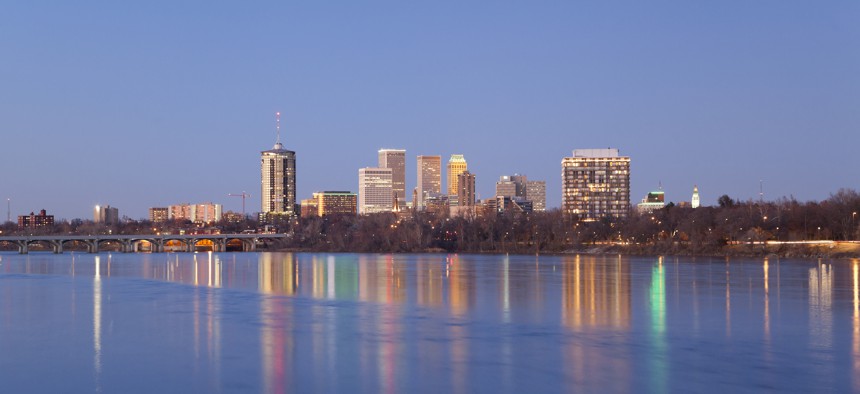What does a resilient city look like?

Tulsa, Oklahoma. chrisp0 via Getty Images
In many cities, resilience is more than climate-ready infrastructure and disaster relief. It’s a tool for building trust in local government, connecting neighbors and uplifting vulnerable communities.
The phrase “resilient city” often conjures images of flood walls, flame-resistant homes and a comprehensive climate mitigation plan. But while those assets are crucial to securing a community’s well-being as the planet warms, resilience is more than the ability to withstand and recover from hurricanes and wildfires. In Tulsa, Oklahoma, building resilience looks like gathering residents together to have difficult—but essential—conversations about race.
Tulsa has a long history of racial tensions and was the site of the largest race massacre in U.S. history, a tragedy that left hundreds dead and razed a prospering Black community. In 2018, the city published its Resilient Tulsa strategy, a plan for building a more resilient community by addressing racial inequities.
As part of Resilient Tulsa, Chief Resilience Officer Krystal Reyes oversees a program that organizes “equity dialogues” by bringing residents together to discuss race. About 100 volunteers are trained to lead these conversations, often hosted in libraries, restaurants or, during the pandemic, over Zoom. The 90-minute discussions allow participants to share their experiences with racism or learn about others’.
The initiative is meant to normalize conversations about race, Reyes said. By making those discussions commonplace, it becomes more intuitive to include equity principles in other processes like creating economic development plans or municipal budgets. The dialogues also help build a sense of community among residents by making space for vulnerability and connecting people who otherwise might not have met. That offers a host of long-term benefits.
“When you have a connected community and trust, you're better able to call on each other in times of crisis, whether that's a natural one or a manmade one.” Reyes said. And when it comes to dealing with the “chronic stressors related to the housing crisis or poverty or mental health—the more community members who know that government is a partner in addressing these [issues], the better.”
Having a cadre of volunteer facilitators who are familiar with Reyes’s office is a bonus, she added, as they can connect with other leadership or job opportunities within local government or lead similar dialogues outside the city’s program.
Tulsa is just one example of a community embracing a broad understanding of resilience. The Resilient Cities Network—a global coalition of nearly 100 cities aiming to build stronger communities—defines urban resilience as “the capacity of a city’s systems, businesses, institutions, communities, and individuals to survive, adapt, and thrive, no matter what chronic stresses and acute shocks they experience.” In short, truly resilient communities are those that not only survive disasters but thrive in non-emergency times, according to Jordana Vasquez, a senior manager for the Resilient Cities Network.
Given the interconnected nature of many of the issues cities face—like poverty, housing, public health, natural disasters, and systemic racism—it’s critical that local leaders maintain a holistic approach to building resilience. That can be difficult as government agencies are commonly siloed and focused on their unique missions, Vasquez said. But local officials need to identify where their priorities align and build from there.
“When we talk about resilience now, in the urban context, it's impossible to just think about one single hazard or a single shock, because they're intertwined,” she said.
Vasquez leads Resilience for Communities, or R4C, a program that helps local governments develop resilience plans by tapping into residents’ lived experiences. She and her team work with historically underserved communities in several cities including Boston, Chicago, Houston and New Orleans. When considering resilience, R4C looks at dozens of indicators that fall within five categories: physical, natural, social, human and financial. Those indicators measures factors like residents’ knowledge of first aid or workers’ rights, business continuity plans, the robustness of the city’s energy supply and other infrastructure, just to name a few. The higher a community scores across the indicators, the more resilient it is.
Partnering with trusted local organizations is critical for encouraging residents to share their ideas, opinions and concerns about proposed solutions, Vasquez said. Community members may be more open to attending workshops and public input meetings hosted at a local nonprofit’s headquarters rather than at city hall, for example. Even residents who are wary of government officials may be encouraged to engage in community development if they see trusted leaders outside the public sector buying into a solution or idea.
“Always try to tap into the local power of influence,” Vasquez said. “It has been great to see the kind of work that I've been able to do and to move forward because of the trust that we gained from the local champions.”






